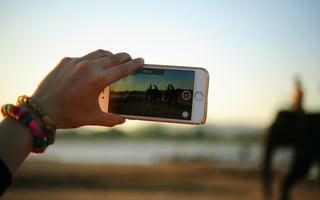Capturing great video has never been easier.
Capturing great video has never been easier.
Everything you need is in your pocket thanks to the meteoric rise of smartphones.
And from the palm of your hand, you can create compelling films that feed the huge appetite for video - people now watch an average of 17 hours of online video a week.
But how can you use your phone to create videos people want to watch?
How can you avoid feeling disappointed with your footage?
What apps and accessories do you need to succeed?
These were some of the questions we tackled in our latest masterclass for Media Team Academy members.
James White, our managing director, was joined in our studios by Toby Sadler.
Toby is a journalist, media and presentation skills trainer and video coach for our clients.
And together they guided members of our learning and development programme through making the most out of filming with your smartphone.
“I’ve been a broadcast journalist for 25 years and that is kind of why I am here on this masterclass,” Toby said.
“All of that video storytelling from news we can now use with that phone in our pocket to tell the news of our organisations.”
He believes that internal comms can often be a good starting point for getting to grips with smartphone videos.
“Internal comms is the first jumping-off point for a lot of people because there is a sense of it being a different quality and wanting to test it internally first,” he said.
“I think that is a good place to begin because you are working with colleagues, so it is essentially a safe space for filming.
“And people quickly realise the quality is good enough for external stuff as well.
“Typically, if I teach a big company, people from internal comms events departments, external comms and trainers will be around the table. Sometimes chief executives send their assistants along because while they may not have time to do filming day in day out, they have someone next to them who can pick up those moments.
“My advice is to start small – a 10 to 15-second clip with a senior leader and three or four shots. We are not expecting you to be making a small movie.
“It is about building your confidence and experimenting. If you don’t try it, then you will never get better at it.
“Occasionally, you will make some terrible films. I have been doing this for a long time, and there is a carefully guarded section of films that never get to be seen by the public because there is no sound or the colour is weird. Or there are people in the background doing things.
“I’ve worked with seasoned camera operators who have been doing it for 30 years, and sometimes they make mistakes.”
James and Toby highlighted four main areas to focus on for your smartphone videos:
- Audio
- Framing
- Lighting
- Software/Apps
Let’s get into them.
Audio
How important is audio in creating high-quality video?
“I think it is fundamental to have good quality audio in your videos, particularly if you are putting your spokespeople up to give information,” Toby said.
“If you are putting them on camera to deliver something for an audience, we need to be able to hear them.
“Generally, 80 per cent of videos on social media are watched without the sound. But there is 20 per cent – a huge amount of people – who are plugging in and listening.”
So, how do you get the audio right?
Toby said: “When you think about audio, we need to think about the sound around us. Before you press record, think about anything that could distract.
“You might be in a beautiful office, but there might be roadworks outside, and if people can’t see them but can hear them, that could be distracting.
“If you are in that situation, you might need to say to people ‘I hope you can hear me over the sound of the worker improving our car park’. Once the audience knows what is making the noise, they can filter it out.”
You then need to consider microphones. Smartphones have them built in, but the audio quality may not be good enough.
James: “The downside of inbuilt microphones on a phone is that they try to capture all the sound. The tech is getting better. But ultimately, it will try to capture everything.”
Toby agrees, adding: “It can be a struggle to listen with all the other noise pollution, and as soon as you ask the audience to do something other than just listen, the engagement goes.”
They recommend using wireless lavalier microphones instead.
Toby: “This is our preferred choice, and the difference in quality is night and day.
“We can easily hear what is being said, and because there is no cable, you can move around easily.”
Other options to consider are lapel microphones and hand-held microphones.
“Microphones don’t have to be expensive,” Toby said.
“You could get a lapel microphone for about £20.
“Have a play with that and learn its limitations.”
Framing
Framing your shot properly is a crucial aspect to consider for shooting mobile video.
And there is plenty to consider.
Toby: “The first thing to consider is the orientation you are filming in – portrait or landscape.
“And it will depend on the output of your video. If you are doing internal comms, it tends to be more landscape. The same for YouTube.
“If you are sending a video with a press release to a trade publication, they might appreciate it in portrait.”
Then you want to position your interviewee and ensure they fill the shot.
“For a traditional news, documentary-style interview, you want the spokesperson to look just to the side of the camera,” Toby said.
“If you are filming in portrait mode, you want a more centre-weighted framing.
“Also, think about how high you have someone in the frame – if you have them low down, you make them seem short.
“If the video is going on social media, consider that there will be text at the bottom of the video - keep that free.
“We want subtitles on everything we put out for the people who are not listening and those who cannot hear. Make video as accessible as possible.”
And you need to think about the shot sequences that will make your video appealing and grab attention.
“The thing with social media is that we need variety to keep people interested – our attention spans have long departed,” Toby said.
“In the first three seconds of a video, you might find there are as many as six shots to grab attention.
“So, we need to get lots of shots. It might be that they are extra shots – what we call B-rolls. Or different shots of the interview – close up, far away, walking around.
“If you speak to a camera operator, they will have names of about 35 different shots.
“We will keep it simple and suggest a wide shot, a medium shot and something super close.
“Record each one for about 10 seconds.
“If you are editing a sequence like this, part of it is controlling time. Imagine someone is driving up a driveway, and it takes 30 seconds – that is quite a tedious film.
“So, we need to control time and ensure there is no continuation issue. To do that, you need a cutaway shot that allows us to distract the audience before coming back to the action.
“A shot of someone’s face is perfect to do that. The person you film needs to focus on what they are doing so it looks natural. You could also do it from over their shoulder.”
The best way to do this is through an app called CapCut.
“Some government departments don’t use it because it is owned by the owners of TikTok,” Toby said.
“But many other people use it because it is so intuitive.
“You can take the A-roll footage – your interviews and pieces to camera – and then add in other clips.”
Should you consider tripods and other equipment?
Toby said: “Hand-held filming rigs give you more stability and are cheap. If you are filming day in, day out, you may want one of the bigger rigs that give you more to hold on to, and you can add power packs and lights.”
Anything else?
Toby recommends you always shoot in 4k at 25 frames per second.
Lighting
Lighting can be the difference between a video that looks good, and one that seems low-quality.
“We need to think about the lighting in the room and what makes it look good or bad,” Toby said.
“We want things to look good.
“We don’t want the video to be distracting with people going ‘Has that person been taken hostage?’ because the lighting is so bad.
“Generally, the best light source available to you is the sun – not necessarily direct sun, but daylight.”
But, if you are in the UK, daylight is in short supply in winter.
“We need to think about bringing in artificial lighting because office lighting is not necessarily flattering.
“And you don’t have to spend a lot of money, as lighting can start at about £20.”
Toby also believes it is vital to use a little lighting etiquette.
“A bright light can make people nervous when you interview them,” he said.
“It can feel a bit much. So, the more you include them in the process, the more relaxed they will be.
“Without any doubt, the first thing people will complain about is the light.
“Ease them in. Tell them you are about to turn on the light and that it will be bright so they can look away.”
“Similarly, if you are interviewing people in bright sunlight, and they are squinting and uncomfortable, you will not get the best out of them. Don’t put them in a position that will make them nervous and irritable.”
During this exclusive session for members of the Media Team Academy, we also looked at the best apps and software, the importance of backgrounds, and the ideal length for you videos. You'll need to join the learning and development programme to read that. Click here to learn more.
Want to explore smartphone video in more depth? Our online course - How to Film and Edit like a Pro on Your Mobile – has you covered. It costs just £195 + vat and you can access it wherever and whenever you want. The course is also included in membership of the Media Team Academy.
Or chat with us about your smartphone video aims and needs.
Media First are media and communications training specialists with over 35 years of experience. We have a team of trainers, each with decades of experience working as journalists, presenters, communications coaches and media trainers.
Click here to learn more about our crisis communication training.
Subscribe here to be among the first to receive our blogs.




